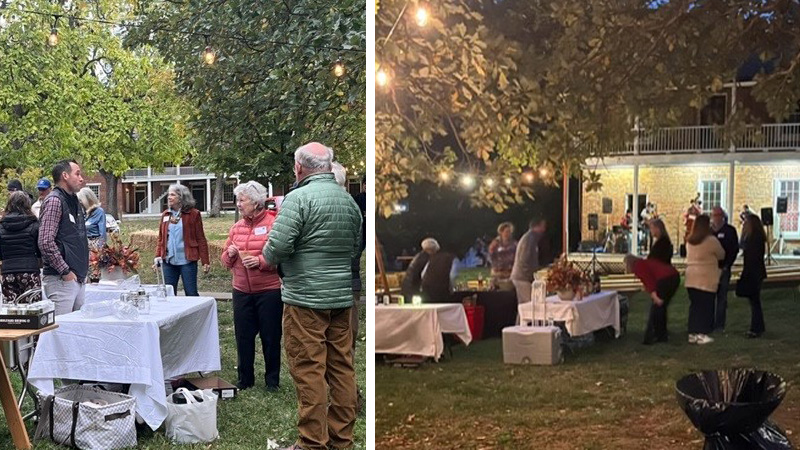Above: Guests Gather at the Reception
With just over 24 hours to go, the team was at work moving boxes, counting last-minute reservations, and tending to the myriad details that mark the difference between an ordinary evening and an extraordinary event. They wanted to be sure that the Night at the Mission, the Friday night overture to the Fall Festival ran smoothly and left everyone eager for another dose of the Mission’s trademark: history that comes to life.
Outside the re-enactors were raising teepees¸ laying fires and loading supplies; the gardeners were pulling weeds and trimming offshoots; and another foursome pulled the covered wagon from its resting site into its featured spot near the center of the yard. Every group, indoors and out, had an assignment; together their mission was to showcase the Mission.
The Fall Festival has been a Mission tradition for decades but this preview party was a first. The brainchild of Jenny Waldeck, who also chaired the Night, the idea was to combine a fund-raising event for the adults with some of the sights and sounds of the Festival.
It was planned as an early evening (many of the guests had to be back on Mission grounds at dawn the next day). So the partytime was carefully paced, starting with an opening reception with live bluegrass music, premium wines, craft beers and signature cocktails. Guests were then divided into small color-coded groups and led through a rotation of truly fascinating presentations. While one group gathered around the covered wagon to hear a costumed historian describe the experience of settlers on the wagon trails, another group stood in front of a teepee with a burning campfire inside and listened to a well-seasoned enactor from the Missouri Free Trappers describe the nomadic life of a trapper in search of beaver skins. Still another group listened as an architectural historian pointed out the distinctive brickwork and craftmanship of Mission buildings. The sessions were timed to allow each group to rotate on cue and visit the next station.
The presenters were so thoroughly immersed in their roles and so impressively versed in their topics that the guests couldn’t decide which was their favorite stop on the rotation. And every guest walked away with two resolutions: 1) impress friends with some newly learned detail of 19th Century life; and 2) put the Night at the Mission on the calendar for next year.
Night at the Mission insight: With the very limited space in a covered wagon (the floor of the wagon was about the size of a standard sheet of plywood), the only extra clothing that the pioneers packed were garments for the largest member of the family. Their rationale: a large adult shirt could always be cut-down and altered into a child’s dress but a child’s pinafore could never morph into a grown man’s shirt.
Night at the Mission insight: In paintings (too early for photographs), frontier trappers are usually pictured in shirts or jackets with long fringe draping from the sleeves. That fringe wasn’t decorative; it was functional. Trapping beavers was a cold, wet pursuit. The long fringe wicked the water away from the sleeve and the fringe, with its extra surface area, dried more quickly than the body of the jacket.

